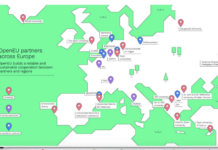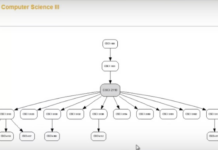
Introduction
This is the third in a series of posts on technology, alienation and online learning, and the first one that deals directly with online learning. The two previous posts were:
- Technology, alienation and the role of education: an introduction
- Technology and alienation: symptoms, causes and a framework for discussion
In this post I want to discuss the rhetoric and reality around labour market skills, and whether approaches such as competency-based learning may do more harm than good in the long run.
In these posts, it is important to understand that I am not attacking the use of online learning in general. There are many advantages to online learning. What I am questioning in these posts is some of the thinking and in particular some of the hype that surrounds what are otherwise valuable contributions to education. In particular, I want to be clear about the risks that are often ignored in the discourse about online learning, and about how to minimize these risks. If we don’t deal with these risks, then online learning could be yet another contribution to alienation.
Labour market needs and competency-based learning
Probably of all the developments in online learning at the moment, competency-based learning is the hottest. The U.S. Secretary of Education, Arne Duncan (2011), praised giving college credit for competency-based learning. President Barack Obama has also spoken in favour of competency-based programs in his proposals to reform higher education (White House Office of the Press Secretary 2013). The U.S. Department of Education is actively encouraging colleges and universities to offer competency-based programs (Field 2013). Many universities, particularly in the USA, are moving in this direction.
Competency-based learning identifies specific competencies or skills, and enables learners to develop mastery of each competency or skill at their own pace, usually working with a mentor. Learners can develop just the competencies or skills they feel they need, for which increasingly they may receive a ‘badge’ or some form of validated recognition, or can combine a whole set of competencies into a full qualification, such as a certificate, diploma or a full degree. A feature of most competency-based programs is a partnership between employers and educators in identifying the competencies required, and assessment based on clear learning outcomes.
There are several benefits in the competency-based learning approach:
- it meets the immediate needs of businesses and professions;
- students may receive advancement within a company associated with the program, or if unemployed, are more likely to be employed once qualified;
- it enables learners with work or family commitments to study at their own pace;
- for some students, it speeds up time to completion of a qualification by enabling them to take the assessment when ready;
- students get individual support and help from their mentors;
- tuition fees are affordable and programs can be self-funding from tuition fees alone;
- competency-based education is being recognized as eligible for Federal loans and student aid in the USA.
For more on competency-based learning, see Chapter 4.5, Teaching in a Digital Age
Drivers of change
There are several key reasons for the growth in competency-based learning:
- the high direct cost of post-secondary education, especially in the USA; competency-based learning is generally much cheaper
- it meets the immediate job needs of both employers and students
- it is much more flexible, particularly for working students, than conventional full-time campus-based education.
The main value proposition and who benefits
- employers get workers with exactly the knowledge and skills that they need
- students have more immediate success in finding jobs
- it lowers the cost of post-secondary education (government and parents)
Risks and danger
The risks are more long-term than short-term. In the short term, competency-based learning is more likely to meet the immediate needs of employers, and students looking for immediate employment or better jobs. However, by definition, competency-based learning is focused not only on the immediate needs as defined by employers, but also on providing just the amount of education needed to meet immediate needs.
This leaves employees educated primarily through competency-based learning vulnerable to major shifts in the labour market. They may end up trained for jobs that no longer exist, and even worse, without the skills or knowledge to adapt to the changing market. Meanwhile, those students who have received a broader education, focused on more general, high level skills, will then have a long term market advantage. In such conditions, those with qualifications through competency-based learning could end up in the lower paid jobs or without work, a prime condition for alienation.
More fundamentally, the concept of competency is limiting. Competency-based learning requires setting learning outcomes that can be accurately measured according to pre-determined standards. Indeed, ‘mastery’, i.e. 95% or more in terms of measuring a competency, is often required. This is different from a skill. A skill has no limit. One continues to improve with learning and experience. This is true particularly of intellectual skills, such as critical thinking, originality, and decision-making, but also applies to even psycho-motor skills. Athletes such as Roger Federer and Lionel Messi never stop practicing, learning and developing. They only stop through the aging process, as their body becomes less strong or over-stressed. Thus measuring a skill that theoretically has no limit is not easy since it may well exceed pre-determined criteria.
What many learners will need in a volatile, uncertain,complex and ambiguous labour market are skills of entrepreneurship, adaptability and resourcefulness. Such skills require a different curriculum and different teaching methods from that of competency-based learning.
Conclusion
I am not arguing against the use of competency-based learning. For certain market conditions and for certain learners, this will be an improvement on traditional post-secondary or higher education. People need jobs now; who knows what the future will bring. Competency-based learning is a particularly valuable teaching method for those already in or recently removed from employment.
However, it will not meet all needs. Indeed, most learners will need, at least initially, an approach to education that allows for greater flexibility and range in the knowledge and skills they need to develop. In particular we should be teaching in such a way that enables learners to continue to learn, to deepen their knowledge, to improve continuously their skills. This should be an education for all learners, not just for an elite few who go to Ivy League universities. Such an approach to education is necessary for all who want a secure and prosperous future. If we limit learners to just competency-based education, we are setting them up for alienation down the road. So we should think of competency-based learning as a supplement to rather than a replacement for a broader education.
Next
Personalized and adaptive learning.
References
Duncan, A. (2011) ‘Beyond the Iron Triangle: Containing the Cost of College and Student Debt.” Remarks of US Secretary of Education Arne Duncan to the annual Federal Student Aid conference, Las Vegas, November 29 http://www.ed.gov/news/speeches/beyond-iron-triangle-containing-cost- college-and-student-debt.
Field, K. (2013) ‘Student Aid Can Be Awarded for Competencies, Not Just Credit Hours, U.S. Says.’ Chronicle of Higher Education, March 19 http://chronicle.com/article/Student-Aid-Can-Be-Awarded -for/137991
United States of America (2013) Fact sheet on the President’s Plan to Make College More Affordable: A Better Bargain for the Middle Class Washington DC: White House Office of the Press Secretary, August 22 http://www.whitehouse.gov/the-press-office/2013/08/22/fact-sheet-president-s-plan-make-college-more-affordable-better-bargain-.









 Dr. Tony Bates is the author of eleven books in the field of online learning and distance education. He has provided consulting services specializing in training in the planning and management of online learning and distance education, working with over 40 organizations in 25 countries. Tony is a Research Associate with Contact North | Contact Nord, Ontario’s Distance Education & Training Network.
Dr. Tony Bates is the author of eleven books in the field of online learning and distance education. He has provided consulting services specializing in training in the planning and management of online learning and distance education, working with over 40 organizations in 25 countries. Tony is a Research Associate with Contact North | Contact Nord, Ontario’s Distance Education & Training Network.


Don’t assume CBE is the sum total of someone’s education. It is more likely a supplement. I see people periodically using CBE to augment life long learning. It comes down to the simple value formula…
value=utility/cost
If the utility (usefulness) is the same i.e. credit/badge/diploma and the cost is lower, this necessitates some portion of the population perceiving higher value. (time is usually a variable of cost)
if you look at what is happening in my country, maybe I would agree with this competency-based learning models. Why? because in my country there are many students or students who complain because they do not know what the purpose of learning curriculum that is provided to them. And in fact I still have not gotten the positive effects of the learning curriculum current in my country. So, I strongly disagree what if in my country adopted this method of teaching berbasi competence, where students and students can focus on the basic capabilities of each participant education. This of course saves time and budget in education. but, this is just my opinion and it is possible education pattern is not matched in other countries, because as we all know, each country has a difference in the life of society and its needs.
I work alongside employers, and their testimonies are invariably the same: no matter how the degree was earned, the candidate could still turn out to be a tree stump at the interview. Online or traditional is not the crux of proper education. Rather, it is whether the student has internalized the knowledge and resynthesized stuff towards forming his own conclusions. The proof is in the pudding. Put a candidate on the job, and he may fail to deliver, regardless of having earned a qualification spending years on campus.